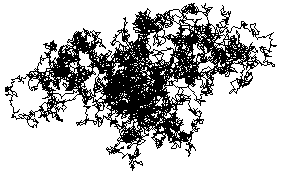
 |
| Finally, we mention a recent theoretical development. |
| A Brownian path in two dimensions can be produced from two independent one-dimensional Brownian functions X(t) and Y(t). |
| Suppose we consider
the range |
| Then the path |
| Visual comparisons between Brownian cluster simulations and the coastlines of islands led Benoit Mandelbrot to conjecture that the periphery of a Brownian Bridge (the part that can be reached from far away without crossing any other point of the cluster) has dimension 4/3. |
| Recently this was proved by Werner, Schramm, and Lawler. |
Return to Brownian Motion.